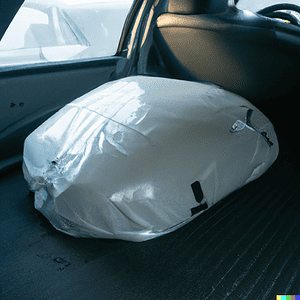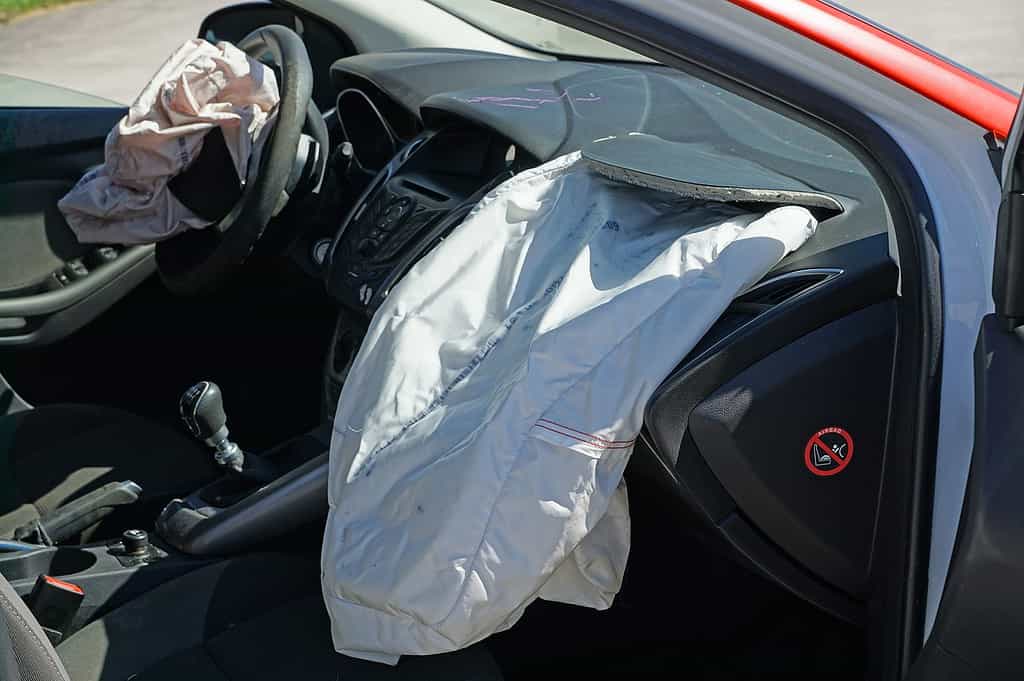Modern cars have highly efficient safety features. From lane-drift alerts to auto braking, there are multiple through which the modern vehicle can protect you from serious injuries.
The airbag is a crucial safety feature that has been around for years. The airbag was invented in the 1950s and has since become the pillar of vehicle safety, and the technology has saved millions of lives.
But despite their effectiveness, airbags may fail to deploy and have you suffering catastrophic car accident injuries. If this happens, you may wonder, “at what speed do airbags deploy?”
Generally, airbags are designed to deploy at certain speeds. That means the speed of the crash is a crucial factor when determining negligence.
This post will discuss in detail how airbags work and the speed at which they deploy. Read on to learn.
How Does an Airbag Work?
Airbags are strategically placed in several areas. But the vehicle’s steering wheel is where they are most commonly positioned.
They can also be positioned in the entire front seat area, protecting the driver and front passenger. Newer car models even have airbags around the front window area or the side cage of the car.

Airbags are connected to specialized sensors and are made of very lightweight material. An airbag’s ignition relay receives a signal from the sensors when they detect a collision.
In a split second, the gas in the airbag immediately inflates, giving passengers almost instant cushioning. This keeps the passengers from slamming into the vehicle’s interior after a collision, protecting them from lacerations, head injuries, spinal cord injuries, etc.
Do All Vehicles Have Airbags?
Yes. Most, if not all, vehicles have airbags. According to federal law, all vehicles manufactured after 1999 should have front airbags.
There are several varieties of airbags, such as:
- Front airbags (which are the most common).
- Side airbags on the sides (for side impact crashes)
- Side curtain airbags (for rollover accidents)
It is important to note that there is no federal requirement for side curtain airbags. However, the US mandates that all car makers adopt a system to prevent occupants from being ejected through side windows.
Vehicles manufactured after 2018 typically have side curtain airbags because they are one of the easiest ways to comply with this requirement.
Airbag Statistics
Over the years, vehicle airbags have reportedly saved more than 50,000 lives, according to the NHTSA. Front airbags have significantly increased front-seat passenger safety by cutting deaths down by nearly a third.
Airbags can lower the risk of death by more than 60% when used alongside safety belts. Although side airbags are less effective in preventing deaths, they can still cut that risk by 37% in side-impact crashes.

But as much as airbags save lives, they can also kill. The NHTSA reports that improper frontal airbag deployment resulted in over 300 fatalities between 1990 and 2008.
But airbag technology is getting safer, and airbags made before 1998 were responsible for 90% of these fatalities. Children and short people are more likely to suffer injuries or death from airbag deployment.
Airbag Injuries
Airbag technology is not perfect. Sensors trigger airbag deployment, but sometimes they can fail, making airbags deploy at the wrong time.
Defective sensors can prevent airbags from inflating completely. The problem is that airbags do not inflate using regular air or oxygen. They rely on gases that may cause respiratory issues if they fail to inflate as designed.
A common effect of a defective airbag is an eye injury, but the worst scenario is probably shrapnel being blasted around the cabin.
Other common airbag injuries include:
- Asthma attacks
- Broken ribs
- Broken wrists
- Burns
- Chest injuries
- Ear trauma
- Facial injuries
- Hearing loss
- Internal bleeding
- Pregnancy complications
- Skull fractures
- TBI (traumatic brain injury)
At What Speed Do Airbags Deploy?
So, at what speed do airbags deploy? Most airbags are set to deploy at different speeds based on the type of airbag and whether the vehicle occupants are wearing seat belts. Let us explore each airbag type to understand when they deploy.
Front airbags
All vehicles, vans, and light trucks manufactured after 1999 must have passenger and driver airbags for frontal accident protection, per federal regulations.
Frontal airbags are designed to activate during moderate to major frontal collisions to protect the occupant’s chest and head from hitting the car’s metal frame.
While frontal airbags are intended to protect all occupants, they provide maximum protection when occupants are belted and sitting in place accordingly.

Newer airbags have a safety belt sensor and an algorithm they use to know if individuals are buckled up. That is how they determine whether to deploy in a specific accident.
For unbelted passengers, airbags deploy at lower speeds, often between 10 and 12mph. Airbags for buckled passengers inflate at 15 to 17mph since belts alone should provide sufficient protection at these moderate speeds.
In both scenarios, the airbag should deploy when the vehicle collides with something equivalent to a solid wall. If there is substantial forward movement during an accident, front airbags could activate to protect people from side impacts.
Side airbags
Side airbags are designed to deploy in side-impact crashes to prevent occupants’ chests and heads from hitting bulging vehicle side structures, another car, or objects like poles or trees.
These airbags cushion and distribute the force of accidents to prevent body parts from exposure to extreme impact forces.
Besides, the window glass can break in an accident. For this reason, a head-shielding side airbag is vital since it could be the only barricade between the occupant’s head and the colliding car.
Since the distance between a passenger and the side of the vehicle is small, side airbags should deploy within 10-20 milliseconds of a side-impact accident.

Deployment parameters range from 8 mph for narrow object accidents (such as collisions with poles and trees) to 18mph for side crashes with greater distribution (such as collisions between vehicles). Side airbags can also inflate in some frontal collisions.
Federal law on side crash safety requires the head and torso of all occupants to be protected. While side airbags are not mandatory, they offer the needed protection.
In fact, almost all new passenger cars made from 2014 to date must adhere to this rule. That means side airbags are a typical feature in most passenger automobiles.
Side curtain airbags
Side curtain airbags are intended to inflate during rollover crashes. Sensors for tracking a car’s sideway movement and tilting trigger deploy when they establish when a rollover is about to happen.
These airbags usually inflate within 10-20 milliseconds after a rollover accident. They may remain deployed for longer (at least 10 seconds) than standard airbags to protect against multiple-role accidents.
They usually seal the window opening and inflate more rigidly to protect the passenger from being ejected.
How to Measure Speed of Airbag Deployment
Estimating the airbag deployment speed during an accident can be tricky. The most effective approach is downloading data from the car’s Event Data Recorder (EDR), sometimes called the “black box.”
Cars are equipped with EDRs so that they can be a computer in the vehicle to determine whether or not airbags should deploy.
Another way is to assess the brake marks left on the roadway. Police experts are qualified to look at these markings and determine the speed of the accident.
Can You File a Lawsuit If Airbags Fail to Deploy?
You may think that it is impossible to win airbag lawsuits. After all, you are fighting against an established automaker.
While these cases can be complex, there still is a chance to get compensated. Take a look at a few airbag cases filed recently:
In October 2022, a woman filed a lawsuit against Porsche when the airbag failed to deploy in a collision in Palm Beach County, leaving her with severe injuries. The woman was a passenger in the car that belonged to a family member.
The car allegedly hit a guardrail when the driver fell asleep while driving. According to the plaintiff, there was a serious impact on the passenger side which should have deployed the airbag, yet it did not offer any protection.
She sustained facial lacerations and fractured vertebrae and is seeking $30,000 in damages. She also claims that Porsche was aware of the safety problems linked with their airbags and did not attempt to address them.
This was just a case of failure to deploy. So, what happens when airbags are faulty to the extent of killing people?

Three people died due to defective Takata airbags on November 3, 2022, increasing the death toll to 32. The airbags are said to be so dysfunctional that they hurl shrapnel through the cabin and cause severe injuries to occupants.
This lawsuit has left Takata bankrupt, and automaker Stellantis has been forced to recall 276,000 cars using these airbags. Affected vehicles are older Chargers, Chrysler 300 sedans, and Dodge Challenger models manufactured between 2005 and 2010.
In other words, airbag deaths and failure to deploy are serious issues in the auto industry. These lawsuits are just a starting point, and with thorough investigation and evidence with the help of an experienced personal injury attorney, you can get compensation for your injuries.
Bottom Line
Finding out when airbags deploy is helpful if you are concerned about safety. Unfortunately, there is nothing you can do to change whether they deploy or not.
If you are involved in an accident and the airbag fails to deploy, you may suffer severe injuries and need a replacement airbag, which can add up to thousands of dollars.
For this reason, you can file a personal injury claim to pursue compensation for your damages with the help of a lawyer.
At Legal Giant, we understand that you are recovering from your injuries and may not be physically fit to vet and hire a lawyer. We can help you hire an experienced personal injury lawyer to help with your case.
Contact us today for a free case evaluation.

